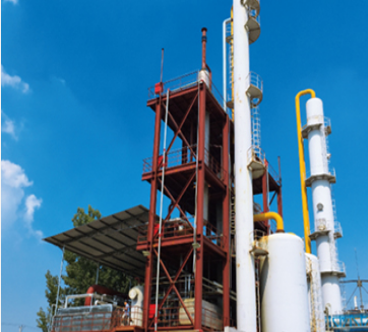針對脫硫廢水的處理����,目前普遍采用氧化、中和、絮凝、沉淀等方法��,主要包括以下幾個步驟:
For the treatment of desulfurization wastewater, oxidation, neutralization, flocculation, sedimentation and other methods are widely used, mainly including the following steps:
1.COD處理
1. Cod treatment
脫硫廢水中的COD大部分來自于二價鐵鹽或以S2O6為主體的硫磺化合物�。對于二價鐵鹽,可通過調節pH至8——10即可在空氣中氧化生成Fe(OH)3沉淀。針對S2O6為主體的硫磺化合物�,若僅采用氧化還原�、活性炭吸附等處理��,很難處理到10mg/L濃度以下���,因此���,目前主要以增設合成吸附劑進行處理為主要手段�����,即進一步使用合成吸附劑吸附處理并用藥品進行脫附���,脫附后的COD以濃溶液形式取出�,再進一步處理。
Most of COD in desulfurization wastewater comes from ferrous salts or sulfur compounds with s2o6 as the main body. For divalent iron salt, Fe (OH) 3 can be oxidized in air by adjusting pH to 8-10. Sulfur compounds with s2o6 as the main body are difficult to be treated below 10mg / L if they are only treated by oxidation-reduction and activated carbon adsorption. Therefore, at present, the main method is to add synthetic adsorbent for treatment, that is, to further use synthetic adsorbent for adsorption treatment and drug desorption, and then take out COD in the form of concentrated solution for further treatment.

2.重金屬的處理
2. Treatment of heavy metals
重金屬的處理主要通過沉淀法實現����。首先投加Ca(OH)2漿液調節pH至9左右�����。此項操作的目的一是為調節pH滿足排放標準,二是將金屬離子以M(OH)n形式析出����,以去除廢水中的金屬離子����,三是利用Ca(OH)2與F-反應生成CaF沉淀的特性除去廢水中的F-����。研究表明,加入廢水中的Ca(OH)2的質量濃度達到900mg/L時���,氟離子濃度可降到5——8mg/L甚至更低,可滿足排放標準要求�����。對于鎘���、汞等重金屬�,應采用硫化物沉淀法��,通過生成更難溶解(離子積常數更?����。┑腗nSm加以去除。
Heavy metals are mainly treated by precipitation. First, add Ca (OH) 2 slurry to adjust pH to about 9. The purpose of this operation is to adjust the pH to meet the discharge standard, precipitate the metal ions in the form of M (OH) n to remove the metal ions in the wastewater, and use the characteristics of CAF precipitation formed by the reaction of Ca (OH) 2 and F - to remove the F - in the wastewater. The results show that when the mass concentration of Ca (OH) 2 in the wastewater reaches 900 mg / L, the fluoride ion concentration can be reduced to 5-8 mg / L or even lower, which can meet the requirements of the discharge standard. For cadmium, mercury and other heavy metals, sulfide precipitation method should be used to remove them by producing mnsm which is more difficult to dissolve (with smaller ion product constant).
3.懸浮物處理
3. Suspended solids treatment
懸浮物的處理主要通過絮凝方法實現��,即通過投加混凝劑�����、助凝劑在水體中發生反應����,絮凝劑在攪拌下分散后并加快水解反應和脫穩�����,使水中膠體態懸浮物脫穩形成細小礬花�����。伴隨微弱攪拌的進行����,礬花不斷成長為大絮體�����,而助凝劑的投加進一步促進絮體成長增加沉淀性�。完全反應后經斜板沉淀池進行沉淀排泥以達到去除的目的���。
The treatment of suspended solids is mainly realized by flocculation, that is, coagulant and coagulant aid are added to react in the water body. After the flocculant is dispersed under stirring, the hydrolysis reaction and destabilization are accelerated, and the colloidal suspended solids in the water are destabilized to form fine alum. With the weak agitation, alum flocs grow into large flocs, and the addition of coagulant aids further promote the growth of flocs and increase the precipitability. After complete reaction, the sludge is precipitated and discharged through inclined plate sedimentation tank to achieve the purpose of removal.
